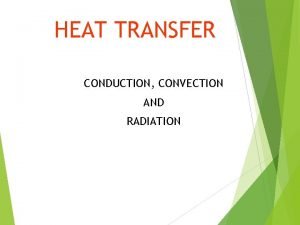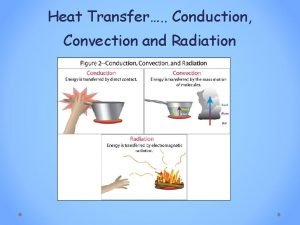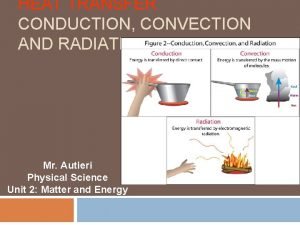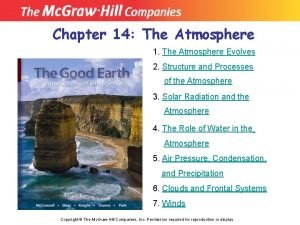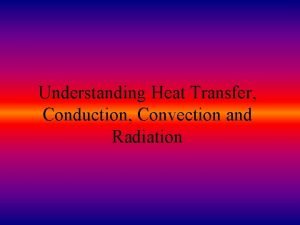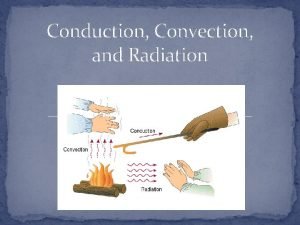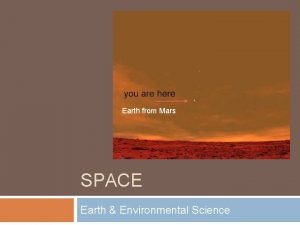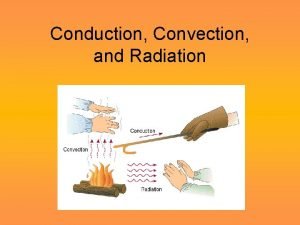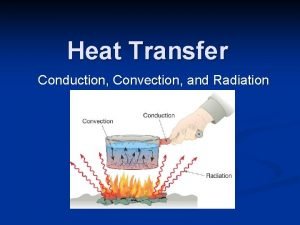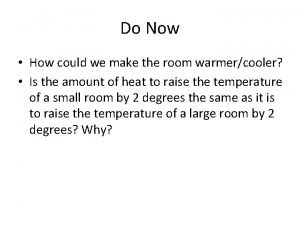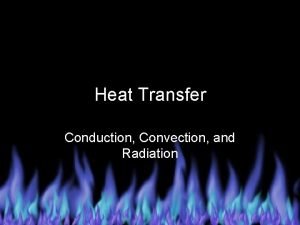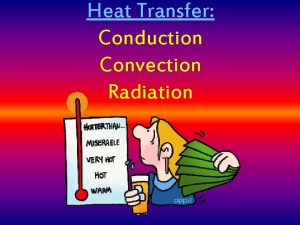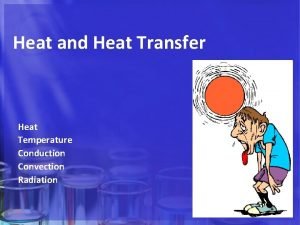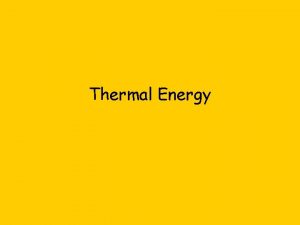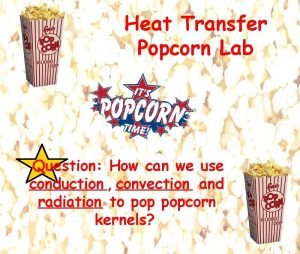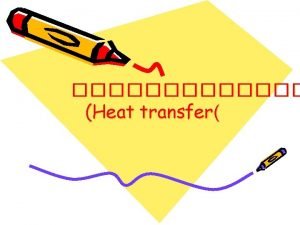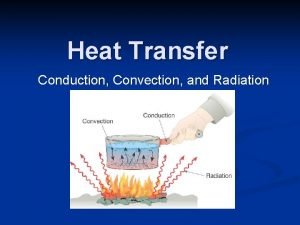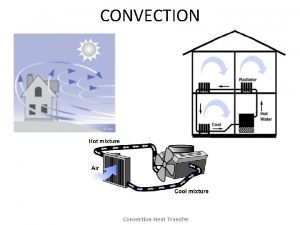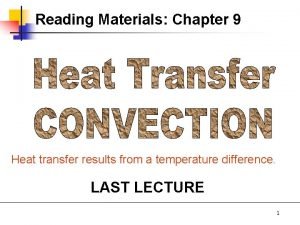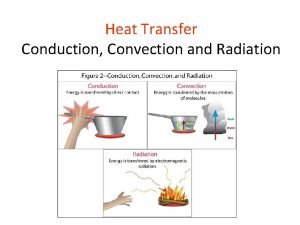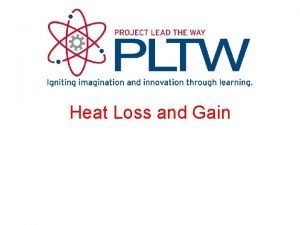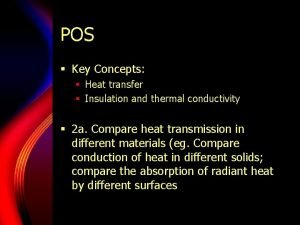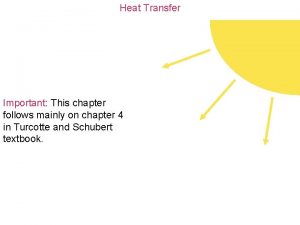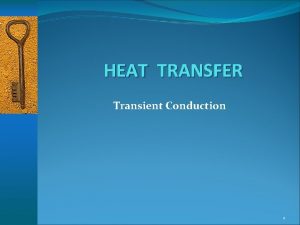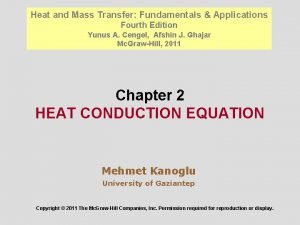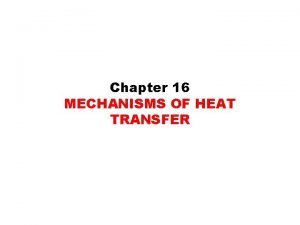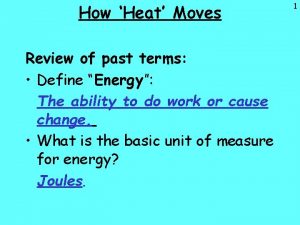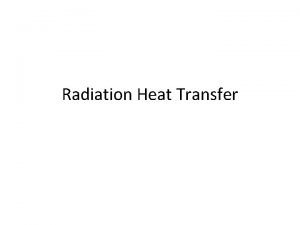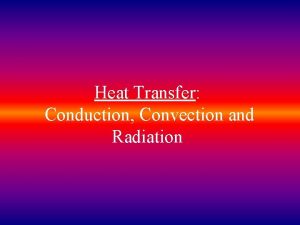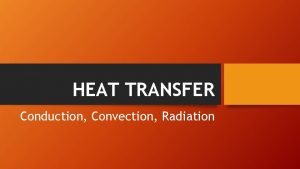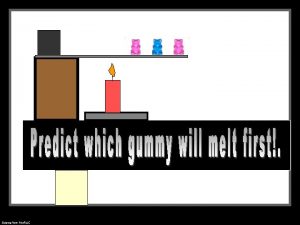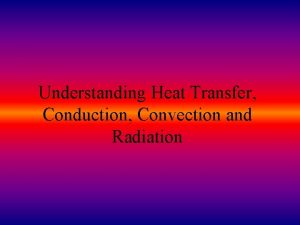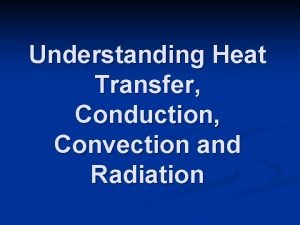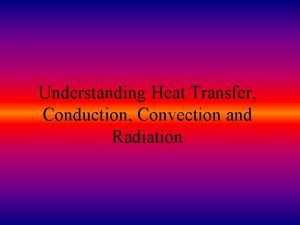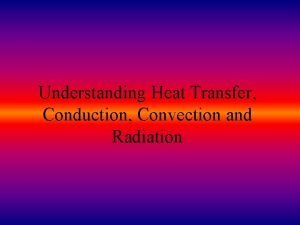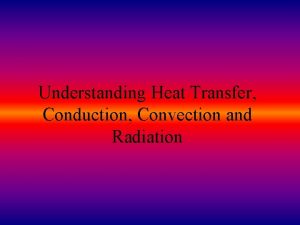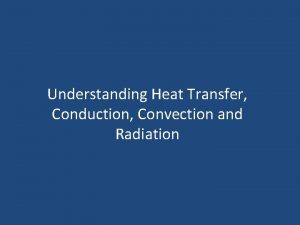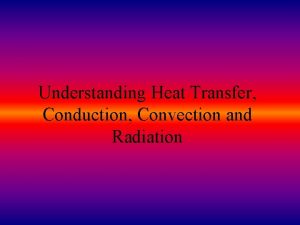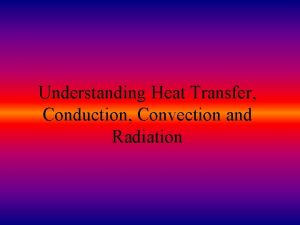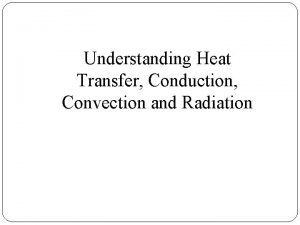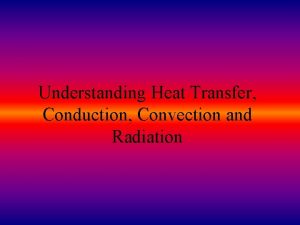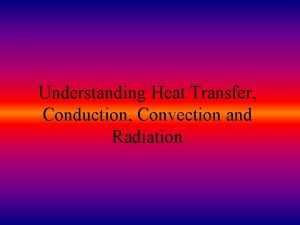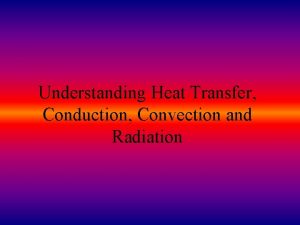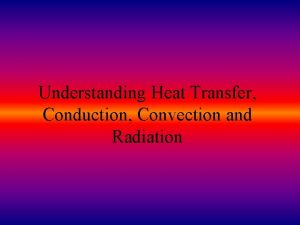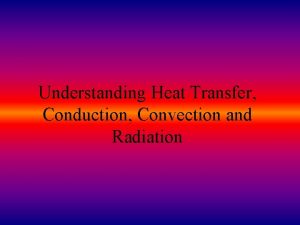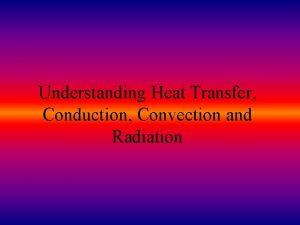Understanding Heat Transfer Conduction Convection and Radiation Unit































- Slides: 31

Understanding Heat Transfer, Conduction, Convection and Radiation Unit 2

In this lesson you will visit: • The way in which heat behaves. • The energy transfer methods; conduction, convection and radiation. • How to reduce heat losses from your home.

Heat Transfer • Heat always moves from a warmer place to a cooler place. – Ex. Your warm skin to a cold stethoscope • Hot objects in a cooler room will cool to room temperature. – Ex. Coffee will cool to room temperature • Cold objects in a warmer room will heat up to room temperature. – Ex. Frozen meat/ice will thaw and become room temperature

Question • If a cup of coffee and an popsicle were left on the table in this room what would happen to them? Why? • The cup of coffee will cool until it reaches room temperature. The lolly will melt and then the liquid will cool to room temperature.

Heat Transfer Methods • These are: – Conduction – Convection – Radiation – Evaporation • We will need to know about the first three of these.

Conduction • The transfer of heat from one object to another through DIRECT contact. (hand signal) • In the pot of soup above – conduction occurs in two ways 1. The pot is sitting on the eye of the stove gathering heat from the eye 2. The spoon is in the soup getting hot from the soup. Thermal energy flows from the hotter object (soup) to the cooler object (spoon) through direct contact.

Conduction When you heat a metal strip at one end, the heat travels to the other end. As you heat the metal, the particles vibrate, these vibrations make the adjacent particles vibrate, and so on, the vibrations are passed along the metal and so is the heat. We call this? Conduction

Conductors vs. Insulators • Conductors – attract/conduct heat • Metals, iron skillet, curling irons, copper pipe, stove coil (burner), cookie sheet • Insulators – prevent the transfer of heat • Blanket, oven mitt, plastic, wood, fiberglass insulation in your house, ceramic bowl

Metals are different The outer e_______ lectrons for metal atoms drift, and are free to move. When the metal is heated, this ‘Sea of inetic electrons’ gain k_____ energy and transfer it throughout the metal. Insulators, such as w___ ood and p____, lastic do not have this ‘Sea of electrons’ which is why they do not conduct heat as well as metals.

Why does metal feel colder than wood, if they are both at the same temperature? Metal is a conductor, wood is an insulator. The metal conducts the heat away from your hands, the wood does not conduct the heat away from your hands as well as the metal, so the wood feels warmer than the metal.

Convection • The transfer of heat by the movement of a liquid or a gas

Heating fluids What happens to the particles in a liquid or a gas when you heat them? The particles spread out and become less dense. This effects What A liquid isfluid aorfluid? gas. movement.

Fluid movement Cooler, more d____, ense fluids sink through w_____, armer less dense fluids. In effect warmer liquids and gases r___ ise up. Cooler liquids and gases s___. ink

Water movement Cools at the surface Cooler water sinks Convection current Hot water rises

Why is it windy at the seaside?

Cold air sinks Where is the freezer compartment put in a fridge? It is put at the top, because cool air sinks, so it cools the food on the way down. Freezer compartment It is warmer at the bottom, so this warmer air rises and a convection current is set up.

Convection • Watch how convection currents work in air. • Even though you cannot see air, you can create a way to see the current. • http: //www. thinkenergy. co. uk/Think. Energy/1114/activities/Convection. Currents. aspx • What made the spiral plate move? ? – Hand signal to display Convection currents

The third method of heat transfer How does heat energy get from the Sun to the Earth? ? There are no particles between the Sun and the Earth so it CANNOT travel by conduction or by convection. RADIATION

Radiation The transfer of energy by electromagnetic waves • Can go through matter or empty space (vacuum) • Examples: sun (visible rays), Ultraviolet waves (invisible), infrared waves from a heater warm your body • Hand signal

Radiation travels in straight lines True/False Radiation can travel through a vacuum True/False Radiation requires particles to travel True/False Radiation travels at the speed of light True/False

Emission experiment Four containers were filled with warm water. Which container would have the warmest water after ten minutes? Dull metal Shiny black Dull black shiny metal container would be the warmest after ten The _____ radiation back minutes because its shiny surface reflects heat _______ dull black container into the container so less is lost. The ____ emitting heat would be the coolest because it is the best at _______ radiation.

Absorption experiment Four containers were placed equidistant from a heater. Which container would have the warmest water after ten minutes? Dull metal Shiny black Dull black dull black container would be the warmest after ten The _____ radiation the best. minutes because its surface absorbs heat _______ shiny metal container would be the coolest because it is The _____ the poorest at _____ absorbing heat radiation.

Reducing Heat Loss From The Home • Heat can be lost through many places at home. These include: – Roof – Walls – Gaps around doors and windows – Floors – Windows

Reducing Heat Loss From The Home • We can reduce heat loss from our homes by using different methods of insulation. • These include: – Double glazing – two panes of glass with air between them – Loft Insulation – Cavity Wall Insulation – Carpets, Curtains, Draught Excluders

Convection questions Why does hot air rise and cold air sink? Cool air is more dense than warm air, so the cool air ‘falls through’ the warm air. Why are boilers placed beneath hot water tanks in people’s homes? Hot water rises. So when the boiler heats the water, and the hot water rises, the water tank is filled with hot water.

Radiation questions Why are houses painted white in hot countries? White reflects heat radiation and keeps the house cooler. Why are shiny foil blankets wrapped around marathon runners at the end of a race? The shiny metal reflects the heat radiation from the runner back in, this stops the runner getting cold.

1. Which of the following is not a method of heat transfer? A. Radiation B. Insulation C. Conduction D. Convection

2. In which of the following are the particles closest together? A. Solid B. Liquid C. Gas D. Fluid

3. How does heat energy reach the Earth from the Sun? A. Radiation B. Conduction C. Convection D. Insulation

4. Which is the best surface for reflecting heat radiation? A. Shiny white B. Dull white C. Shiny black D. Dull black

5. Which is the best surface for absorbing heat radiation? A. Shiny white B. Dull white C. Shiny black D. Dull black
 What is heat transfer conduction convection and radiation
What is heat transfer conduction convection and radiation Radiation heat transfer examples
Radiation heat transfer examples Heat transfers
Heat transfers Heat transfer by conduction convection and radiation
Heat transfer by conduction convection and radiation How is thermal energy transferred?
How is thermal energy transferred? Venn diagram solid and liquid
Venn diagram solid and liquid Venn diagram of conduction, convection and radiation
Venn diagram of conduction, convection and radiation Whats a convection current
Whats a convection current Heat energy is transferred by conduction whenever molecules
Heat energy is transferred by conduction whenever molecules Convection conduction radiation
Convection conduction radiation Radiation examples
Radiation examples How are conduction convection and radiation alike
How are conduction convection and radiation alike Following charting convection used in work study
Following charting convection used in work study Example of conduction
Example of conduction Radiation heat transfer examples
Radiation heat transfer examples Temperature,conduction,convection, radiation
Temperature,conduction,convection, radiation Bellringer conduction convection or radiation
Bellringer conduction convection or radiation Conduction convection radiation popcorn lab
Conduction convection radiation popcorn lab Conduction convection radiation equations
Conduction convection radiation equations Because of convection, the warmest air in a room _____.
Because of convection, the warmest air in a room _____. Temperature conduction convection radiation
Temperature conduction convection radiation Vertical
Vertical Convection heat transfer
Convection heat transfer Example of adiabatic process
Example of adiabatic process Thermal conductivity formula
Thermal conductivity formula Conduction vs insulation
Conduction vs insulation Heat transfer
Heat transfer 5'0 in cm
5'0 in cm Variable thermal conductivity
Variable thermal conductivity Objectives of heat transfer
Objectives of heat transfer How heat moves
How heat moves Example of heat transfer by radiation
Example of heat transfer by radiation

